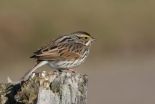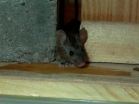(Press-News.org) Birds use their bills largely to forage and eat, and these behaviors strongly influence the shape and size of a bird's bill. But the bill can play an important role in regulating the bird's body temperature by acting as a radiator for excess heat. A team of scientists have found that because of this, high summer temperatures have been a strong influence in determining bill size in some birds, particularly species of sparrows that favor salt marshes. The team's findings are published in the scientific journal Ecography, July 20.
Scientists at the Smithsonian Migratory Bird Center at the Smithsonian's Conservation Biology Institute and colleagues examined five species of sparrow that inhabit salt marshes on the East, West and Gulf coasts of North America. While these marshes are very similar in makeup and structure, the main difference among them is summer temperatures. Focusing on 10 species and subspecies of tidal salt marsh sparrow, the team measured 1,380 specimens and found that the variation in the sparrows' bill size was strongly related to the variation in the daily high summer temperatures of their salt marsh breeding habitats—the higher the average summer temperature, the larger the bill. Birds pump blood into tissue inside the bill at high temperatures and the body's heat is released into the air. Because larger bills have a greater surface area than smaller bills, they serve as more effective thermoregulatory organs under hot conditions. On average, the study found the bills of sparrows in marshes with high summer temperatures to be up to 90 percent larger than those of the same species in cooler marshes.
"It is known that blood flow is increased in poorly insulated extremities in some animals, like a seal's flippers, a rabbit's ears and the wattles of a turkey helping hot animals to cool down. The bill of a bird can function in much the same way allowing birds to dump heat," said Russ Greenberg, director of the Smithsonian Migratory Bird Center and lead author of the research. "Being able to cool down and not loose excess body moisture is particularly important since these birds live in an environment with direct sun and limited access to fresh water."
The scientific theory known as Allen's Rule states that warm-blooded species from colder climates usually have shorter limbs or appendages than the equivalent animals from warmer climates. The team's new findings are a new example of Allen's Rule that confirms the importance of physiological constraints on the evolution of vertebrate morphologies, even in bird bills.
The research team is working with physiologists from Brock University in Canada, employing thermal imaging to develop a more detail picture of how song sparrows that live in dunes and marshes along the Atlantic coast use their bills to stay cool.
INFORMATION:
It's no sweat for salt marsh sparrows to beat the heat if they have a larger bill
2011-07-22
ELSE PRESS RELEASES FROM THIS DATE:
Unlisted ingredients in teas and herbal brews revealed in DNA tests by high school students
2011-07-22
Take a second look at your iced or steaming tea. Guided by scientific experts, three New York City high school students using tabletop DNA technologies found several herbal brews and a few brands of tea contain ingredients unlisted on the manufacturers' package.
The teen sleuths also demonstrated new-to-science genetic variation between broad-leaf teas from exported from India versus small-leaf teas exported from China.
Guided by DNA "barcoding" experts at The Rockefeller University, an ethno-botanist at Tufts University and a molecular botany expert at The New York ...
UCSF study highlights success of brain surgery for severe epilepsy
2011-07-22
Two-thirds of people with severe and otherwise untreatable epilepsy were completely cured of their frequent seizures after undergoing neurosurgery at the University of California, San Francisco Medical Center, according to a new study that examined 143 of these patients two years after their operations.
The new study not only shows the promise of this type of neurosurgery at treating severe epilepsy, it also highlights how research into brain imaging may help to further improve results for people who have such operations.
"Surgery can be a powerful way to stop this ...
Whole sequence variation map reveals insight into evolutionary studies of rhesus macaque
2011-07-22
July 20, 2011 – BGI (previously known as the Beijing Genomics Institute), the largest genomics organization in the world, and Kunming Institute of Zoology, Chinese Academy of Sciences, together published the whole sequence variation map of rhesus macaque (Macaca mulatta) in Genome Biology on July 6th, 2011 (http://genomebiology.com/2011/12/7/R63). The study provides available resources for evolutionary and biomedical research.
Rhesus macaque, also called the Rhesus monkey, is one of the best known species of old world monkeys. Human and Rhesus macaque share a most recent ...
Cedars-Sinai movement disorders expert on international task force for dystonia treatment
2011-07-22
LOS ANGELES (July 20, 2011) –Neurologist Michele Tagliati, MD, director of the Movement Disorders Program at Cedars-Sinai Medical Center, served on an elite international task force commissioned by the Movement Disorder Society to provide insights and guidance on deep brain stimulation for dystonia, an uncommon condition that causes sustained, sometimes crippling muscle contractions.
The resulting articles, describing the data reviewed and outlining the group's conclusions, recommendations and points to be addressed in future research, published online last month in ...
Computer simulations aid understanding of bacterial resistance against commonly used antibiotics
2011-07-22
A recent study into the interactions between aminoglycoside antibiotics and their target site in bacteria used computer simulations to elucidate this mechanism and thereby suggest drug modifications.
In the article, which will be published on July 21st in the open-access journal PLoS Computational Biology, researchers from University of Warsaw, Poland, and University of California San Diego, USA, describe their study of the physical basis of one bacterial resistance mechanism - mutations of the antibiotic target site, namely RNA of the bacterial ribosome. They performed ...
Chromosome number changes in yeast
2011-07-22
Researchers from Trinity College Dublin have uncovered the evolutionary mechanisms that have caused increases or decreases in the numbers of chromosomes in a group of yeast species during the last 100-150 million years. The study, to be published on July 21st in the open-access journal PLoS Genetics, offers an unprecedented view of chromosome complement (chromosome number) changes in a large group of related species.
A few specific cases of chromosome number changes have been studied in plants and animals, for example the fusion of two great ape chromosomes that gave ...
'Freaky mouse' defeats common poison
2011-07-22
HOUSTON -- (July 21, 2011) -- Over millennia, mice have thrived despite humanity's efforts to keep them at bay. A Rice University scientist argues some mice have found two ways to achieve a single goal -- resistance to common poison.
New research by Michael Kohn and colleagues, reported today in the online journal Current Biology, analyzes a genetic mutation that has given the ordinary European house mouse this extraordinary ability.
The gene in question, vkorc1, is present in all mammals and manages vitamin K. A mutation to vkorc1 makes mice resistant to warfarin, ...
Skin sentry cells promote distinct immune responses
2011-07-22
A new study reveals that just as different soldiers in the field have different jobs, subsets of a type of immune cell that polices the barriers of the body can promote unique and opposite immune responses against the same type of infection. The research, published online on July 21st by Cell Press in the journal Immunity, enhances our understanding of the early stages of the immune response and may have important implications for vaccinations and treatment of autoimmune diseases.
Dendritic cells serve as sentries of the immune system and are stationed at the body's ...
As agricultural riches waylay pollinators, an endangered tree suffers
2011-07-22
For the conservation of species, hostile territory might sometimes have its advantages. That's according to a study of pollen flow among trees found only in remnant patches of native Chilean forest. The data show that the pollinators those rare trees rely on can be waylaid by the abundance of resources found in agricultural lands. As a result, trees growing in native forest patches are more likely to mate successfully when separated by resource-poor pine plantations than by those more attractive farmlands.
The finding reported in the July 21st Current Biology, a Cell ...
With secondhand gene, house mice resist poison
2011-07-22
Since the 1950s, people have tried to limit the numbers of mice and rats using a poison known as warfarin. But, over the course of evolution, those pesky rodents have found a way to make a comeback, resisting that chemical via changes to a gene involved in vitamin K recycling and blood clotting. Now, researchers reporting online on July 21 in Current Biology, a Cell Press publication, show that European mice have in some cases acquired that resistance gene in a rather unorthodox way: they got it secondhand from an Algerian mouse.
"House mice not only have become resistant ...


